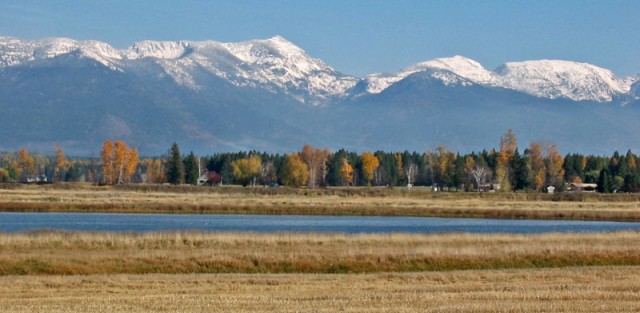What is a Watershed Restoration Plan and what is it used for?
A Watershed Restoration Plan (WRP) is a document that provides framework for managing, protecting, and restoring water resources on a watershed-wide scale. The creation of this plan fulfills one of the requirements set by the Environmental Protection Agency (EPA) for groups who wish to receive grants under Section 319 of the federal Clean Water Act (CWA) for non point source (nps) pollution restoration projects on impaired streams.
The Montana Department of Environmental Quality (DEQ) is the entity that decides which streams are impaired and for which pollutants. When a stream is declared “impaired” it means that the stream no longer meets the State of Montana’s standards on clean water for a given pollutant – for example: if a stream is impaired for sediment, it means that the concentration of sediment in the stream is higher than what is healthy, whether it be unhealthy for aquatic life, recreational activities, or drinking water. The three main pollutants in the Flathead-Stillwater Watershed are excess sediment, excess nutrients, and high stream temperatures. These impaired streams are assessed every two years and are listed in the 2014 DEQ Water Quality Integrated Report and in the most recent 2016 Draft DEQ Water Quality Integrated Report.
Flathead-Stillwater Watershed Restoration Plan
 The Flathead Conservation District (FCD) created a plan for the Flathead-Stillwater Watershed in response to the completion of the Flathead-Stillwater Total Maximum Daily Load (TMDL) in 2014. The WRP focuses restoration efforts on listed impaired streams in this TMDL. Other streams of concern listed by the FCD and local stakeholders are also included in the WRP.
The Flathead Conservation District (FCD) created a plan for the Flathead-Stillwater Watershed in response to the completion of the Flathead-Stillwater Total Maximum Daily Load (TMDL) in 2014. The WRP focuses restoration efforts on listed impaired streams in this TMDL. Other streams of concern listed by the FCD and local stakeholders are also included in the WRP.
Flathead-Stillwater Watershed Restoration Plan
The WRP may be used by other watershed groups and stream shore landowners in the Flathead-Stillwater Watershed to restore impaired streams and streams of concern using Best Management Practices (BMPs) and other restoration techniques.
Map of the Flathead-Stillwater Watershed identifying impaired streams.
Which streams are impaired?
| Waterbodies in the Flathead-Stillwater Watershed with listed impairments on Montana DEQ’s 2014 list of impaired waters plus other streams of concern. | ||
| Water Body | Causes of Impairment | Impaired Use |
| Ashley Creek – Ashley Lake to mouth
(Flathead River) |
Total Nitrogen, Total Phosphorous, Sediment, Temperature | Aquatic Life, Primary Contact Recreation |
| Spring Creek – Headwaters to mouth (Ashley Creek) | Total Nitrogen, Total Phosphorous | Aquatic Life, Primary Contact Recreation |
| Haskill Creek – Haskill Basin Pond to mouth (Whitefish River) | Sediment | Aquatic Life |
| Stillwater River – Logan Creek to mouth (Flathead River) | Sediment | Aquatic Life |
| Whitefish River – Whitefish Lake to mouth (Stillwater River) | Temperature | Aquatic Life |
| Logan Creek – Headwaters to Tally Lake | Sediment | Aquatic Life |
| Sheppard Creek – Headwaters to mouth (Griffin Creek) | Sediment | Aquatic Life |
| Coal Creek – Headwaters to mouth (North Fork Flathead) | Sediment | Aquatic Life |
| Trumbull Creek – Headwaters to mouth (Stillwater River) | Sediment, Flooding | Stream of concern, not listed as impaired by DEQ |
| Krause Creek – Headwaters to mouth (Echo Lake) | Sediment | Stream of concern, not listed as impaired by DEQ |
| Cow Creek – Headwaters to mouth (Whitefish River) | Total Nitrogen, Total Phosphorous, Sediment, Temperature | Stream of concern, not listed as impaired by DEQ |
| Walker Creek – Headwaters to mouth (Whitefish River) | Total Nitrogen, Total Phosphorous, Sediment, Temperature | Stream of concern, not listed as impaired by DEQ |
| Swan River – Swan Lake to Flathead Lake | Sediment | Stream of concern, not listed as impaired by DEQ |
| Flathead River – Main stem (Columbia Falls) to Flathead Lake | Sediment | Stream of concern, not listed as impaired by DEQ |
| Stoner Creek – Headwaters to mouth (Flathead Lake) | Sediment | Stream of concern, not listed as impaired by DEQ |
One goal of the WRP is that landowners owning property along the listed impaired streams or the streams of concern will consider learning more about NPS pollution and will want to enhance their property to protect our water resources. We also hope to involve the greater community in educational workshops and events to teach not only students, but people of all ages about NPS pollution and its effects on water quality.
Due to the large scope of this WRP, the main focus of this document for the first couple of years will be on supporting and finishing current projects that directly affect the NPS pollution loads in listed streams. During this time, efforts will be made to reach out to new landowners and community members to promote interest in future restoration projects and workshops.
Want to learn more?
Source Water Collaborative Water Quality Interactive Info-graphic
Montana DEQ Nonpoint Source Program
